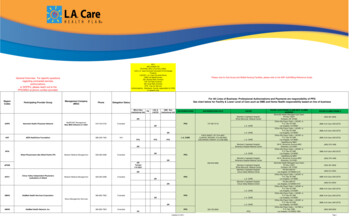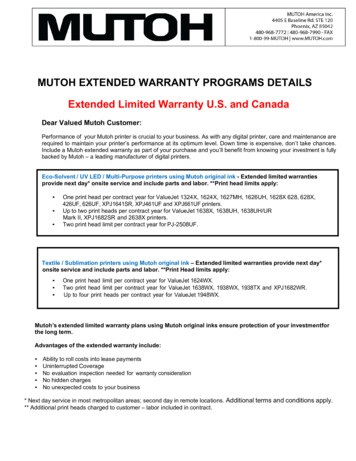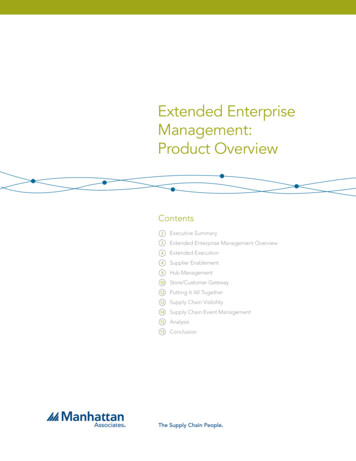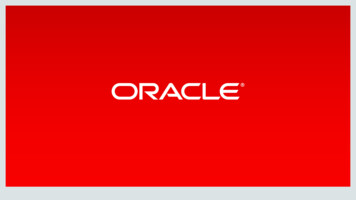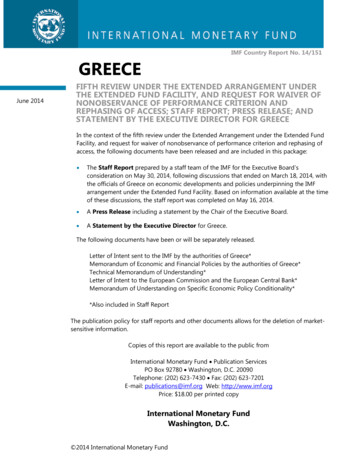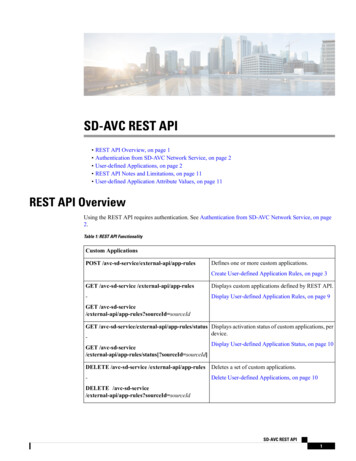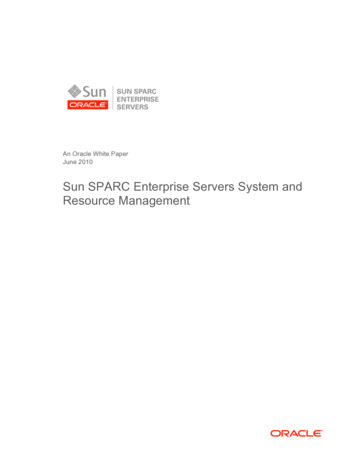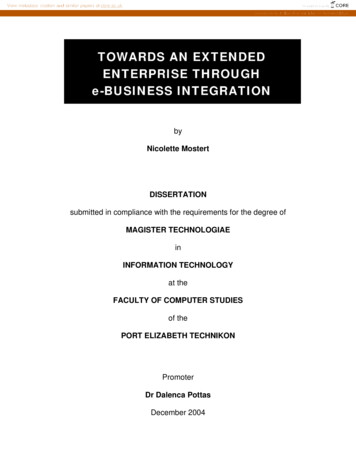
Transcription
View metadata, citation and similar papers at core.ac.ukbrought to you byCOREprovided by South East Academic Libraries System (SEALS)TOWARDS AN EXTENDEDENTERPRISE THROUGHe-BUSINESS INTEGRATIONbyNicolette MostertDISSERTATIONsubmitted in compliance with the requirements for the degree ofMAGISTER TECHNOLOGIAEinINFORMATION TECHNOLOGYat theFACULTY OF COMPUTER STUDIESof thePORT ELIZABETH TECHNIKONPromoterDr Dalenca PottasDecember 2004
“ It is not the strongest of the species that survives,nor the most intelligent - it is the one that ismost adaptable to change. ”Charles Darwin
DECLARATIONI, Nicolette Mostert, hereby declare that: The work in this dissertation is my own work. All sources used or referred to have been documented and recognized. This dissertation has not previously been submitted in full or partialfulfillment of the requirements for an equivalent or higher qualification atany other recognized education institute.Nicolette Mostert
ACKNOWLEDGEMENTThe financial assistance of the Department of Labour (DoL) towards thisresearch is hereby acknowledged. Opinions expressed and conclusionsarrived at, are those of the author and are not necessarily to be attributed tothe DoL.
CONTENTSPAGELIST OF FIGURES1LIST OF TABLES2LIST OF ACRONYMS3CHAPTER 1INTRODUCTION51.1 Introduction61.2 The Extended Enterprise81.3 e-Business Integration91.3.1Enterprise Application Integration (EAI)101.3.2Business-to-Business Integration (B2Bi)101.4 Problem Definition111.5 Objectives121.6 Methodology131.7 Layout of Dissertation131.8 Conclusion15CHAPTER 2THE EXTENDED ENTERPRISE162.1 Introduction172.2 Extended and Virtual Enterprises19-i-
CONTENTS2.32.4The Extended Enterprise: An Information Systems-BasedView2.3.1 Introduction222.3.2Enterprise Resource Planning (ERP)242.3.3Customer Relationship Management (CRM)242.3.4Supply Chain Management (SCM)252.3.5Conclusion25Conclusion2226CHAPTER 3e-BUSINESS INTEGRATION293.1Introduction303.2The Agile Enterprise313.3Intra-Enterprise Integration333.4Inter-Enterprise Integration363.5EAI B2Bi e-Business Integration373.6Conclusion37CHAPTER 4INTEGRATION APPROACHES394.1Introduction404.2Data-Oriented Integration414.2.1Extract, Transform, and Load (ETL)454.2.2Data Replication464.2.3Data Federation484.3User Interface-Oriented Integration494.3.1Screen Scraping504.3.2Content Aggregation52- ii -
CONTENTS4.4Application Interface-Oriented Integration544.5Service-Oriented Integration594.6Process-Oriented Integration614.7Conclusion64CHAPTER 5INTEGRATION TECHNOLOGIES AND tabase-Oriented Middleware675.2.1.1 Native database-oriented middleware685.2.1.2 Call-level interfaces (CLIs)695.2.1.3 Database gateways705.2.2Remote Procedure Calls715.2.3Distributed Objects725.2.3.1 CORBA735.2.3.2 COM/DCOM755.2.3.3 Java RMI765.2.4Transactional Middleware765.2.5Message-Oriented Middleware785.2.6Broker-Based taNet825.3.3BizTalk835.3.4ebXML84Conclusion84- iii -
CONTENTSCHAPTER 6TOWARDS AN EXTENDED ENTERPRISE:86THE EXTENDED ENTERPRISE INTEGRATION MODEL6.1Introduction876.2The Extended Enterprise Integration Model876.3Realization of Integration Need886.4Phase 1: Determine Integration Readiness896.4.1Determine Whether There Is A Need For Integration896.4.2Determine Possible Impact Of Integration906.4.3Identify Business Advisors And Project Champion916.56.66.7Phase 2: Determine Business Goals926.5.1Determine Business Goals926.5.2Evaluate Business Goals93Phase 3: Specify Integration Requirements946.6.1Specify Functional Integration Requirements946.6.2Specify Non-Functional Integration Requirements956.6.3Evaluate Integration Requirements96Phase 4: Define Integration Strategy976.7.197Determine Whether Intra- And/Or Inter-EnterpriseIntegration Is Necessary6.86.7.2Determine Integration Stages986.7.3Consider Technological Factors986.7.4Evaluate Integration Strategy100Phase 5: Select Integration Approach And Vendor1006.8.1Select Integration Approach(es)1006.8.2Select Integration Vendor(s)1026.8.3Evaluate Selected Integration Approach(es) andVendor(s)103- iv -
CONTENTS6.9Phase 6: Deployment1046.9.1Implement Pilot Project1046.9.2Evaluate Pilot Project1046.9.3Deploy Integration Stage1056.9.4Evaluate Integration Stage1066.10 Phase 7: Evaluation6.10.1Determine Whether Business Goals and Integration106107Requirements Are Satisfied6.10.2 Document Problems Encountered1076.11 Support Functions1086.12 Conclusion109CHAPTER 7DEPLOYING THE EXTENDED ENTERPRISE111INTEGRATION MODEL7.1Introduction1127.2The Extended Enterprise Example1127.3Realization of Integration Need1137.4Phase 1: Determine Integration Readiness1147.4.1Determine Whether There Is A Need For Integration1147.4.2Determine Possible Impact Of Integration1177.4.3Identify Business Advisors And Project Champion1187.57.6Phase 2: Determine Business Goals1197.5.1Determine Business Goals1197.5.2Evaluate Business Goals120Phase 3: Specify Integration Requirements1217.6.1121Specify Functional Integration Requirements-v-
CONTENTS7.77.6.2Specify Non-Functional Integration Requirements1237.6.3Evaluate Integration Requirements124Phase 4: Define Integration Strategy1257.7.1125Determine Whether Intra- And/Or Inter-EnterpriseIntegration Is Necessary7.87.97.7.2Determine Integration Stages1267.7.3Consider Technological Factors1267.7.4Evaluate Integration Strategy127Phase 5: Select Integration Approach And Vendor1287.8.1Select Integration Approach(es)1287.8.2Select Integration Vendor(s)1287.8.3Evaluate Selected Integration Approach and Vendor129Phase 6: Deployment1297.9.1Implement Pilot Project1297.9.2Evaluate Pilot Project1307.9.3Deploy Integration Stage1307.9.4Evaluate Integration Stage1317.10 Phase 7: Evaluation7.10.1Determine Whether Business Goals and Integration131131Requirements Are Satisfied7.10.2 Document Problems Encountered7.11 Conclusion132133CHAPTER 8e-BUSINESS INTEGRATION: BENEFITS ANDBARRIERS1348.1Introduction1358.2The Benefits Of Implementing An e-Business Integration135Strategy- vi -
CONTENTS8.38.2.1Cost Savings1368.2.2Resource Savings1378.2.3Time Savings1378.2.4Improved Information Usage139The Realities Of Implementing An e-Business Integration142Strategy8.4Conclusion143CHAPTER 9CONCLUSION1459.1Introduction1469.2Chapter Overview1489.3Future Research1499.4Conclusion150BIBLIOGRAPHY152APPENDIX A169- vii -
LIST OF FIGURESFIGURE TITLE1.12.1PAGECriticality of integration to the organization.7The extended enterprise - an Information Systems-23based view.3.1The core of agility.324.1Data exchanged between a single target and source42system.4.2Data exchanged between a single target and multiple42source systems.4.3Data consolidated from multiple sources to a single43target.4.4Data consolidated from multiple sources to multiple44targets.4.5Data moved from one database to another.474.6A virtual database creates a single, unified view of48underlying esother63Client system invoking a procedure on server system71integration approaches.5.1through a function call.6.1The Extended Enterprise Integration Model110PAGE 1 OF 176
LIST OF TABLESTABLE TITLE2.1PAGEComparison of the extended enterprise and the virtual20enterprise.PAGE 2 OF 176
LIST OF ACRONYMSAPIApplication Programming siness IntegrationBPMBusiness Process ManagementBPMSBusiness Process Management SystemCLICall-Level InterfaceCOMComponent Object ModelCORBACommon Object Request Broker ArchitectureCRMCustomer Relationship ManagementDCOMDistributed Component Object ModelEAIEnterprise Application IntegrationebXMLElectronic Business XMLEDIElectronic Data InterchangeEJBEnterprise JavaBeansERPEnterprise Resource PlanningESBEnterprise Service BusETLExtract, Transform, and LoadICTInformation and Communication TechnologyITInformation TechnologyJDBCJava Database ConnectivityPAGE 3 OF 176
LIST OF ACRONYMSJSPJava Server PagesJVMJava Virtual MachineMOMMessage-Oriented MiddlewareODBCOpen Database ConnectivityOLEObject Linking and EmbeddingORBObject Request BrokerPIPPartner Interface ProcessRMIRemote Method InvocationRNIFRosettaNet Implementation FrameworkROIReturn On InvestmentRPCRemote Procedure CallSCMSupply Chain ManagementSOAPSimple Object Access ProtocolTPTransaction ProcessingUDDIUniversal Description, Discovery and IntegrationWSDLWeb Services Description LanguageXMLExtensible Markup LanguagePAGE 4 OF 176
CHAPTER 1INTRODUCTIONChapter 1 serves as an introduction to the remainder of this dissertation.The reader is introduced to the problem domain and the problemaddressed by this research project is stated. In addition, the objectives ofthis study are established.In Chapter 2 the reader is introduced to the concept of an extendedenterprise.
CHAPTER 1INTRODUCTION1.1 INTRODUCTIONIn the global business environment organizations face findnewopportunities to increase efficiencies and increase profitability. Oneincreasingly popular approach is to form extended enterprises wherestrategic relations between the organization and its suppliers,customers and other business partners help to provide a competitiveedge over competitors (Active Software, 2000; Lublinsky, 2002). Inorder for the extended enterprise to be successful, it is important thatrelevant, up-to-date information is available to all participants at alltimes. Traditional ways of doing business, such as e-mail, faxes andvoice mail, introduce delays and as a result, another solution must befound to share data, services and processes between the members ofthe extended enterprise. During these difficult economic timesorganizations are not willing to invest in new systems that will enablecollaboration between the members of the extended enterprise.Instead, interest in integrating relevant existing systems between themembers of the extended enterprise to allow for the sharing of data,services and business processes is growing (Reese, 2002).The response to IDC’s Integration Drivers Study, 2002 reflects theincreasing importance of integration projects, as can be seen in Figure1.1 (Hailstone, Vermeulen & Warmerdam, 2002). In addition, thegrowing importance of integration can be seen in the evolution that hastaken place in organizations regarding who within the organizationconsidered integration to be important. Instead of just the ITdepartment feeling that integration is critical, the business leaders ofthe organization are increasingly looking to integration to improve keyperformance indicators (Reese, 2002).PAGE 6 OF 176
CHAPTER 1INTRODUCTIONPLEASE RATE HOW IMPORTANT ENTERPRISEINTEGRATION IS TO YOUR ENTIRE ORGANIZATION:Useful, but not forour businessactivities (3.0%)Not required at all(0.5%)Needed for somebusiness activities(15.7%)Key enabler forbusiness-criticalactivities (50.7%)Mandatory formission criticalactivities (30,1%)FIGURE 1.1: Criticality of integration to the organization (Hailstone,Vermeulen & Warmerdam, 2002).The focus of this project will be on introducing the concept of anextended enterprise to business leaders, subsequently presenting eBusiness Integration and the supporting role that it can play in theestablishment of an extended enterprise. Various literature sources willbe consolidated to describe the integration approaches and supportingintegration technologies and standards that can be employed inestablishing integrated communication between the members of theextended enterprise. Finally, a phased approach will be proposed thatcan be employed in supporting the establishment of an extendedenterprise through e-Business Integration.PAGE 7 OF 176
CHAPTER 1INTRODUCTION1.2 THE EXTENDED ENTERPRISEThe term extended enterprise represents the concept that anorganization does not only consist of its employees, board members,and executives, but also its business partners, suppliers andcustomers. This collaboration is done to streamline business processesand enhance customer benefits (IFS, 2003).When consideringexisting EDI-based collaboration, the extended enterprise is not anentirely new concept, but what distinguishes the extended enterprise isthat it aims for much more interactive services, higher flexibility, lowerinvestments, and a considerably larger reach and richness in itscollaboration (IFS, 2003). In order for the extended enterprise to besuccessful, it is important that relevant, up-to-date information isavailable to all participants at all times. To achieve this, the informationsystems of the organization must operate within a distributedapplication architecture (Cherry Tree, 2000).At the core of the organization is the Enterprise Resource Planning(ERP) backbone, which is a primarily inward facing application thattracks the internal flow of information. To create an extended enterpriseit is necessary that its information systems face outward to ustomers.Applications that extend the organization outwards include CustomerRelationship Management (CRM) and Supply Chain Management(SCM) systems. These outward facing systems must be fully integratedwith the ERP backbone for the organization to become a truly extendedenterprise (Cherry Tree, 2000). Despite the value that can be derivedfrom integrating the outward facing systems with the core of theenterprise, this final step in the creation of the extended enterprise iswhere most businesses fail. This is due to the fact that these systemswere never designed to communicate with each other and the task ofPAGE 8 OF 176
CHAPTER 1INTRODUCTIONintegrating these systems remains elusive for even the most highlyrespected systems integrators (Cherry Tree, 2000). This integrationchallenge has resulted in the creation of disconnected applicationsthroughout the organization, often referred to as stovepipes, islands ofautomation, or even vertical application silos. These islands ofautomation are unaware of events outside their domain and to solvethis problem it is necessary to use various tools and technologies tointegrate the entire extended enterprise (Cherry Tree, 2000).1.3 e-BUSINESS INTEGRATIONUntil recently, most integration projects have focused on intraenterprise integration, or application integration that occurs within thefirewall of the enterprise. This is known as Enterprise ApplicationIntegration (EAI). With the emergence of extended enterprises, interenterprise integration has become a priority. This involves theintegration of applications with external business partners, suppliersand customers across the firewall. Integration across the firewall is alsoknown as Business-to-Business Integration (B2Bi) (Linthicum, 2000).The EAI and B2Bi markets are merging to form the e-BusinessIntegration market (Aberdeen, 2003). A significant driver for thissituation is the fact that you must be able to integrate your internalinformation systems before you can integrate with the external systemsof your business partners, suppliers and customers.This study will focus on both Enterprise Application Integration (EAI)and Business-to-Business Integration (B2Bi), which will be discussed inmore detail in the following two sections.PAGE 9 OF 176
CHAPTER 1INTRODUCTION1.3.1 ENTERPRISE APPLICATION INTEGRATION (EAI)According to the EAI Industry Consortium, EAI can be definedas the process of integrating multiple applications that wereindependently developed, may use incompatible technology,and remain independently managed (20032). EAI enablespreviously isolated systems within an organization to beintegrated with related information and processes in chnologies, 2003): leverage valuable data in legacy and homegrown systems integrate legacy systems with newer technologies that willbe important for current and future operations facilitate flexible data access and flow for ever changingbusiness needs, and incorporate any unstructured data, such as e-mail, forbusiness use.It becomes clear that EAI can enable the organization to adaptrapidly to the ever-changing business environment. To positionthe organization for even greater success it is necessary tointegrate the systems within the organization with the systemsof all business partners, suppliers and customers of theenterprise. To achieve this, business-to-business integration isnecessary.1.3.2 BUSINESS-TO-BUSINESS INTEGRATION (B2Bi)B2Bi refers to the controlled sharing of data and businessprocesses among any connected applications and datasources across organizational boundaries using the Internet.PAGE 10 OF 176
CHAPTER 1INTRODUCTIONB2Bi allows organizations to link, for example, their SAPsystem to their supplier's Baan system and move informationbetween them as needed to create an extended enterprise(Linthicum, 2000). In addition to the benefits of EAI, B2Bi canproduce the following benefits for the organization (iSource,2003): improved response times for inter-enterprise processes customer satisfaction due to improved purchasing processand shorter response times automation of high volumes of transactions betweentrading partners, and reduction in administrative costs.1.4 PROBLEM DEFINITIONIncreased collaboration is necessary between an organization and itssuppliers, customers, and other business partners, collectively knownas the extended enterprise, in order to stay competitive in the globalmarketplace. A higher level of collaboration can facilitate immediatereaction to current business events, as well as lead to considerablecost savings and improved organizational efficiency. e-BusinessIntegration can be used to integrate relevant target and source systemsto allow data, services, processes, and so forth to be shared, in orderto support the establishment of this higher level of collaborationbetween the members of the extended enterprise. Despite the benefitsthat e-Business Integration can bring in supporting the establishment ofan extended enterprise, business leaders are hesitant to invest in moretechnology solutions during slow economic times. The problem beingaddressed in this study relates to introducing business leaders to theconcept of an extended enterprise, and then providing relevantinformation that can be understood by non-technical business leadersPAGE 11 OF 176
CHAPTER 1INTRODUCTIONon how e-Business Integration can support the establishment of theimportance of e-Business Integration in the establishment of anextended enterprise it is necessary to provide them with an approachthat they can work towards in the creation of an extended enterprise.This will typically involve achieving intra-enterprise integration first, andthen advancing to inter-enterprise integration.Effectively addressing the above problem would ensure that theobjectives in section 1.5 are achieved.1.5 OBJECTIVESThe principal objective of this study is to provide business leaders withan approach that can be followed when implementing e-BusinessIntegration to support the establishment of an extended enterprise. Inaddition, it is also necessary to introduce business leaders to theconcept of an extended enterprise and highlight the supporting role thate-Business Integration can play in establishing an extended enterprise.It is necessary to research and formulate the concept of an extendedenterprise, as well as the concepts of intra- and inter-enterpriseintegration, which collectively forms the e-Business Integration market,in order to develop such an approach. In addition, it is necessary thatthese business leaders have a basic understanding of the variousintegration approaches that can be applied to integrate systems, aswell as the enabling middleware technologies and standards employedin these integration approaches.The following methodology will be followed in order to reach theseobjectives.PAGE 12 OF 176
CHAPTER 1INTRODUCTION1.6 METHODOLOGYAn extensive literature study will form the basis of the research. Theproblem will be examined by discussing the following topics: the concept of an extended enterprise e-Business Integration, including Enterprise Application Integration(EAI) and Business-to-Business Integration (B2Bi) integration approaches, and integration technologies and standards.Using the knowledge gained during this study, a model representingthe phases that integration initiatives should undergo to establishintegrated communication between the members of the extendedenterprise will be developed.1.7 LAYOUT OF DISSERTATIONChapter 1 – IntroductionProvides some background information on the research area in order todefine the problem.Chapter 2 – The Extended EnterpriseThis chapter will discuss the concept of an extended enterprise.Chapter 3 – e-Business IntegrationIn this chapter intra- and inter-enterprise integration, which collectivelyform the e-Business Integration market, will be discussed.PAGE 13 OF 176
CHAPTER 1INTRODUCTIONChapter 4 – Integration ApproachesThe various integration approaches that can be employed to achieveeither intra- or inter-enterprise integration will be described.Chapter 5 – Integration Technologies and StandardsIn this chapter several integration technologies and standards that canbe employed to develop either intra- or inter-enterprise integrationsolutions will be discussed.Chapter 6 – Towards an Extended Enterprise: The ExtendedEnterprise Integration ModelA model that proposes a phased approach to achieving integrationbetween the systems of the members of the extended enterprise isintroduced.Chapter 7 – Employing the Extended Enterprise Integration ModelIn this chapter an example is used to illustrate how the phasedapproach proposed by the Extended Enterprise Integration Model canbe used to achieve intra-enterprise integration.Chapter 8 – e-Business Integration: Benefits and BarriersThis chapter discusses the role that e-Business Integration plays insupporting the establishment of an extended enterprise, as well as therealities of employing e-Business Integration.Chapter 9 – ConclusionThe research is concluded in this chapter.PAGE 14 OF 176
CHAPTER 1INTRODUCTION1.8 CONCLUSIONThe problems that will be addressed by this research project weredefined and the objectives of the project stated in this chapter. Theapproach taken to solve the problems were discussed and the layout ofthe dissertation shown.The concept of an extended enterprise will be discussed in thefollowing chapter.PAGE 15 OF 176
CHAPTER 2THE EXTENDED ENTERPRISEChapter 1 establishes the necessity of the research documented in thisdissertation and introduces the reader to the problem domain.This chapter introduces the reader to the concept of an extendedenterprise and includes a discussion on the difference between anextended- and a virtual enterprise. The extended enterprise is alsoevaluated from an Information Systems-based viewpoint.In Chapter 3 e-Business Integration will be discussed and the role that itcan play in solving communication problems between the members of theextended enterprise will be highlighted.
CHAPTER 2THE EXTENDED ENTERPRISE2.1 INTRODUCTIONThe evolution of the Internet has a significant impact on the way thatorganizations operate. According to Kalakota and Robinson the,evolution of the Internet can be divided into phases (2000). During thefirst phase (1994 – 1997) the emphasis was on creating a webpresence, while the second phase (1997 – 2000) focused onperforming transactions over digital media. Today, with the Internet erain its third phase (2000 - ?), the focus is on how the Internet can impactprofitability. With the abundance of product information available on theInternet, consumers can compare prices and services with the click ofa button before making a purchasing decision. This leads to increasedcompetition and shrinking profit margins. This phenomenon forcesorganizations to investigate other alternatives for increasing profits.Organizations are looking beyond their traditional boundaries to formdynamic relationships with the members of their extended enterprisesin order to remain competitive and exploit profitable opportunities in avolatile economy (Power, Sohal & Rahman, 2001).The extended enterprise is a term used to describe the collaborationand high level of interdependence that exists between an organizationand its customers, suppliers and other business partners (Browne &Zhang, 1999). Competitive advantage not only involves internalefficiency in the extended enterprise, but the ability of the organizationto share information and coordinate activity and requirements with themembers of its extended enterprise as well. Dramatic savings of timeand money can be realized through collaboration between themembers of the extended enterprise (Nickerson, 2002). The realcompetition is no longer between individual organizations in currentmarket conditions, but rather between extended enterprises (Alshawi,2001; Surgency & IBM, 2002).PAGE 17 OF 176
CHAPTER 2THE EXTENDED ENTERPRISEConsider the following example of an extended enterprise involved inthe supply of potato chips, in order to explain the concept of anextended enterprise (adapted from (Alshawi, 2001)).Even though there could be quite a number of organizations workingtogether to manufacture potato chips, the most prominent members ofthe extended enterprise would include the following: the farmer who grows the potatoes the package manufacturer who supplies the bags that the potatochips are sold in the actual manufacturer of the potato chips the trucking company that delivers the product to supermarkets,and the supermarket where the product is sold.Collaboration between these members of the extended enterprise iscritical to its success as a whole. The farmer needs information aboutpotato chip sales projections when planning his planting andharvesting of a potato crop, while the actual potato chip manufacturerneeds information about crop conditions to plan his productionschedule (Alshawi, 2001).The above description of an extended enterprise may, to many people,seem to describe a virtual enterprise as well, but there is a subtledifference between an extended enterprise and a virtual enterprise.The difference between an extended enterprise and a virtual enterprisewill be discussed in the next section.PAGE 18 OF 176
CHAPTER 2THE EXTENDED ENTERPRISE2.2 EXTENDED AND VIRTUAL ENTERPRISESThere is a difference, which primarily relates to the purpose of theenterprise, while its description seems to relate to a virtual enterpriseas well. The focus is on long-term relationships across the value chainin the extended enterprise, to enable the members of the extendedenterprise to eliminate costs, streamline business processes, enhancemutual customer benefits and thus to gain strategic competitiveadvantage. The virtual enterprise signifies a more short-term, dynamicenvironment where relationships between organizations exist for arelatively short time to satisfy certain market demands quickly (Browne& Zhang, 1999). A virtual enterprise may be established to produce aparticular product or to deliver a particular service and when themarket for that product or service deteriorates it is dissolved.Table 2.1 presents a further comparison between an extendedenterprise and a virtual enterprise.PAGE 19 OF 176
CHAPTER 2THE EXTENDED ENTERPRISEEXTENDED ENTERPRISEVIRTUAL ENTERPRISESTRATEGIC ISSUEStronger long-term objectiveStronger short-time objectiveMEMBERSHIPLong-term business co-operationTemporary co-operation to deliver new productor servicePURPOSEORGANIZATIONALStable grouping of organizations across theDynamic grouping of organizations with coreSTABILITYproduct value chaincompetencesMEMBERTrust and mutual dependence for long termTemporary and dynamicBOUNDARIESFull blurring for long termPartly blurring for short termORGANIZATIONProduct value-chain based to co-ordinate totalFrequently project or niche market basedTYPEproduct life-cycleCO-ORDINATIONUsually the manufacturerFrequently a broker manages the co-operationFacilitated and enabled by ICTsOperation depends on sophisticated ICTsRELATIONSHIPSOF T)TABLE 2.1: A comparison of the extended enterprise and the virtual enterprise (Browne & Zhang, 1999).PAGE 20 OF 176
CHAPTER 2THE EXTENDED ENTERPRISEThe major difference between these two enterprises lies in the relativestability of the extended enterprise versus the temporary and dynamicnature of the virtual enterprise. The requirement in the extendedenterprise for organizational stability, trust and lasting relationships ishigh, while the focus in the virtual enterprise is on the temporarycoming together of organizations to produce a particular product, or todeliver a particular service, quickly to satisfy a specific market need.Despite the differences mentioned, the similarity between theenterprises lies in the fact that both pursue enterprise partnerships inorder to achieve success and remain competitive in a very volatile,competitive marketplace (Browne & Zhang, 1999).While the success of both enterprises depends on information sharing,the virtual enterprise depends more on information technology tofacilitate fast and accurate transactions, while in the extendedenterprise the challenge of creating and sustaining it is moremanagerial, and concerned with the design and implementation ofappropriate business processes. Despite this, the efficiency of theextended enterprise is to a great extent determined by the level ofcompatibility between the Information Systems of the members, as wellas how effectively they can leverage these systems to maximize thesharing of information and the coordination of activities (Browne &Zhang, 1999).In the next section the extended enterprise will bediscussed from an Information Systems-based viewpoint.PAGE 21 OF 176
CHAPTER 2THE EXTENDED ENTERPRISE2.3 THE EXTENDED ENTERPRISE: ANINFORMATION SYSTEMS-
5.3.3 BizTalk 83 5.3.4 ebXML 84 5.4 Conclusion 84. CONTENTS - iv - CHAPTER 6 TOWARDS AN EXTENDED ENTERPRISE: THE EXTENDED ENTERPRISE INTEGRATION MODEL 86 . ESB Enterprise Service Bus ETL Extract, Transform, and Load ICT Information and Communication Technology IT Information Technology JDBC Java Database Connectivity
